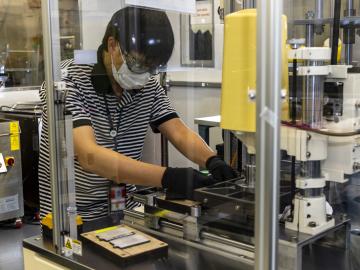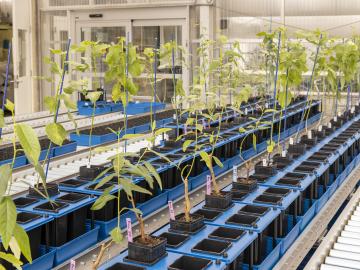
Filter News
Area of Research
- Advanced Manufacturing (3)
- Biological Systems (2)
- Biology and Environment (57)
- Biology and Soft Matter (1)
- Computational Engineering (1)
- Computer Science (4)
- Energy Science (75)
- Energy Sciences (1)
- Fusion and Fission (5)
- Fusion Energy (1)
- Isotope Development and Production (1)
- Isotopes (21)
- Materials (54)
- Materials for Computing (8)
- National Security (10)
- Neutron Science (15)
- Nuclear Science and Technology (4)
- Quantum information Science (3)
- Supercomputing (46)
- Transportation Systems (1)
News Type
News Topics
- (-) Big Data (62)
- (-) Bioenergy (84)
- (-) Composites (21)
- (-) Energy Storage (64)
- (-) Frontier (45)
- (-) Irradiation (2)
- (-) Isotopes (38)
- (-) Nanotechnology (29)
- (-) Physics (38)
- 3-D Printing/Advanced Manufacturing (89)
- Advanced Reactors (25)
- Artificial Intelligence (92)
- Biology (100)
- Biomedical (53)
- Biotechnology (28)
- Buildings (50)
- Chemical Sciences (48)
- Clean Water (30)
- Computer Science (153)
- Coronavirus (30)
- Critical Materials (17)
- Cybersecurity (17)
- Education (2)
- Emergency (4)
- Environment (164)
- Exascale Computing (52)
- Fossil Energy (7)
- Fusion (47)
- Grid (54)
- High-Performance Computing (93)
- Hydropower (12)
- ITER (7)
- Machine Learning (51)
- Materials (87)
- Materials Science (89)
- Mathematics (11)
- Mercury (10)
- Microelectronics (3)
- Microscopy (34)
- Molten Salt (7)
- National Security (63)
- Neutron Science (109)
- Nuclear Energy (85)
- Partnerships (37)
- Polymers (18)
- Quantum Computing (39)
- Quantum Science (58)
- Security (17)
- Simulation (51)
- Software (1)
- Space Exploration (23)
- Statistics (3)
- Summit (48)
- Transportation (66)
Media Contacts

Popular wisdom holds tall, fast-growing trees are best for biomass, but new research by two U.S. Department of Energy national laboratories reveals that is only part of the equation.

Scientists at Oak Ridge National Laboratory and the University of Tennessee designed and demonstrated a method to make carbon-based materials that can be used as electrodes compatible with a specific semiconductor circuitry.

Soteria Battery Innovation Group has exclusively licensed and optioned a technology developed by Oak Ridge National Laboratory designed to eliminate thermal runaway in lithium ion batteries due to mechanical damage.


Rufus Ritchie came from Kentucky coal country, a region not known for producing physicists.

Scientists at ORNL and the University of Nebraska have developed an easier way to generate electrons for nanoscale imaging and sensing, providing a useful new tool for material science, bioimaging and fundamental quantum research.

Radioactive isotopes power some of NASA’s best-known spacecraft. But predicting how radiation emitted from these isotopes might affect nearby materials is tricky

Systems biologist Paul Abraham uses his fascination with proteins, the molecular machines of nature, to explore new ways to engineer more productive ecosystems and hardier bioenergy crops.

Scientists at the Department of Energy’s Oak Ridge National Laboratory have a powerful new tool in the quest to produce better plants for biofuels, bioproducts and agriculture.


